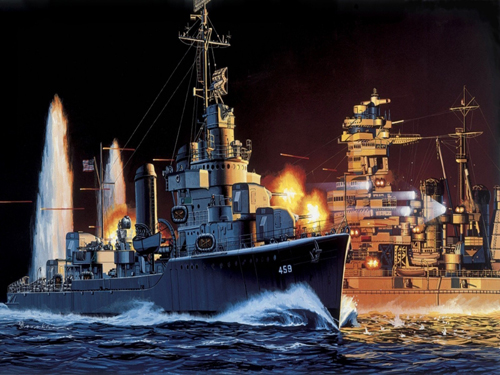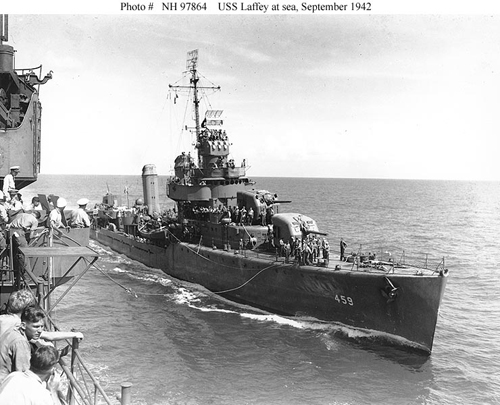
Painting depicting the USS Laffey attacking the Japan Battleship Hiei in the early morning hours of November 13, 1942.
This past November 13th was the 70th anniversary of one of the most famous naval battles of World War II. The United States entered World War II when war with Japan was declared on December 8, 1941 the day after the Japanese attacked the U.S. naval base at Pearl Harbor. The Guadalcanal Campaign, also known as the Battle of Guadalcanal, was a military campaign fought between August 1942 and February 1943 on and around the island of Guadalcanal in the Pacific Ocean. It was the first major offensive by U.S. forces against Japan in World War II. During the Guadalcanal Campaign the United States was also joined by Allies Britain, New Zealand, and Australia in the war against Japan.
On August 7, 1942, an Allied invasion force landed the First Marine Division of the United States on the island of Guadalcanal. The Japanese had occupied the island and were building a strategically important airfield. The Marines easily overwhelmed the outnumbered Japanese defenders and captured the airfield which was then completed and put into service as Henderson Field. Surprised by the landings, the Japanese made several attempts to retake Henderson Field. Three major land battles, seven large naval battles and almost daily aerial battles comprised the Guadalcanal Campaign.
The USS Laffey (DD-459) was a destroyer (a Destroyer is a fast and maneuverable small sized warship) in the U.S. Navy named for Civil War Hero Bartlett Laffey, who was a Medal of Honor recipient. The USS Laffey was 347 feet long, 36 feet wide, weighed 1,620 tons, and had a crew of 208 men under the command of Lieutenant Commander William Hank. Laffey was armed with four 5-inch diameter guns in single turrets, five 20mm anti-aircraft guns, three torpedo tubes, depth charges for attacking submarines, and some smaller guns. Placed in service on March 31, 1942, Laffey was sent to the Pacific Ocean in August as an escort for the Aircraft Carrier USS Wasp. When the Wasp was attacked by the Japanese Submarine I-19 a month later on September 13, the Laffey and three other ships rescued 1,946 men from the sinking aircraft carrier. Laffey was sent to the area around Guadalcanal five days later.
The USS Laffey saw her first action in the Battle of Cape Esperance (also called the Second Battle of Savo Island) on October 11-12 1942. During this battle, Laffey attacked the Japanese Cruiser Aoba with her 5-inch guns causing serious damage. (a Cruiser is a type of medium-sized warship) While the Aoba managed to escape to the Japanese base at Truk, it was so seriously damaged it had to be sent to Japan for repairs. Three other Japanese ships and two U.S. ships were sunk during this battle.
The Naval Battle of Guadalcanal (also called the Third Battle of Savo Island) took place from November 12-13 1942. Japanese Naval Forces under the command of Admiral Hiroaki Abe consisted of two battleships, one cruiser, eleven destroyers, and eleven transport ships. The transport ships were carrying 7,000 Japanese army troops and their supplies to Guadalcanal. The two Japanese Battleships; the Hiei and Kirishima were both World War I era Battleships, but had been extensively rebuilt by the Japanese into “Fast Battleships” armed with eight 14-inch guns, sixteen 6-inch guns, and eight 5-inch guns. For this mission the Hiei and Kirishima were equipped with special 14-inch fragmentation shells and were to bombard Henderson Field and surrounding Allied troop positions in support of the Japanese landings. The U.S. Naval Forces protecting Guadalcanal at the time were under the command of Admiral Daniel Callaghan and consisted of five cruisers and eight destroyers which included the USS Laffey.
At about 1:25AM on November 13, in near-complete darkness because of bad weather and no moon, the Japanese ships arrived from an unexpected direction to the area of Guadalcanal and prepared to bombard Henderson Field. Five of the U.S. ships had radar, but Admiral Callaghan had put none of them in the forward part of his forces. Some of the ships with radar detected the Japanese ships on radar, but had trouble communicating the information to Admiral Callaghan on board the Cruiser USS San Francisco because of problems with their radio equipment and other factors. Several minutes later, both the Japanese and U.S. forces sighted each other at the same time. Admiral Abe, who was on board the Japanese Battleship Hiei, was surprised by the U.S. ships and with his main guns loaded with fragmentation (verses anti-ship armor penetrating) shells could not decide if he should withdraw to give his two battleships time to change ammunition or to continue onward.He decided to continue onward. Admiral Callaghan was confused by the incomplete information he received and the U.S. ship formation began to fall apart as Callaghan tried to ascertain what was going on. Meanwhile, both the Japanese and U.S. ship formations began to intermingle with each other.
At 1:48AM some of the Japanese ships turned on their searchlights and lit up a U.S. Cruiser only 3,000 yards away which was point-blank range for naval guns. Several of the ships on both sides opened fire. Realizing that his force was surrounded by Japanese ships, Admiral Callaghan issued confusing firing orders as most of the U.S. ships opened fire. As the ships from the two sides intermingled, they fired on each other at close distances. Afterwards a survivor from the Destroyer USS Monssen said the battle was like “a barroom brawl after the lights had been shot out”.
During the Battle, the USS Laffey passed within 20 feet of the Japanese Battleship Hiei. The Battleship was unable to aim her 14-inch guns low enough to hit the small destroyer, but Laffey was able to rake Hiei’s bridge superstructure with 5-inch shells and anti-aircraft gunfire, causing heavy damage to Hiei’s control center, wounding Admiral Abe, and killing some of his staff. Admiral Abe was severely hampered in his ability to direct his ships for the rest of the battle. The U.S. Destroyers Sterett and O’Bannon also attacked the Hiei after the drive-by from the USS Laffey.
The USS Laffey, having escaped from her engagement with the Battleship Hiei, encountered four Japanese Destroyers which pounded Laffey with gunfire and then hit her with a torpedo causing serious damage. A few minutes’ later fires reached the ammunition storage areas on the Laffey and as the order to abandon ship was given a violent explosion ripped the destroyer apart and she sank immediately;59 men were killed including Commander William Hank. The Japanese Battleship Hiei, severely damaged and unable to steer, sank the next day after Japanese efforts to tow her failed.
Including the Laffey, the November 13 naval action cost U.S. Forces four destroyers and two cruisers sunk while the Japanese lost the Battleship Hiei, two destroyers, and seven of the transport ships. U.S. Admiral Callaghan was killed when the USS San Francisco was shelled by the Japanese Battleship Hiei during the battle. The Guadalcanal Campaign ended in February 1943 in a victory for the United States and its Allies. Total losses for the Guadalcanal Campaign were 7,100 killed, 29 ships sank, 615 airplanes lost for the U.S. and its Allies compared to 31,000 killed, 38 ships sank, and 880 airplanes lost for the Japanese Forces.
The USS Laffey was awarded the Presidential Unit Citation and three battle stars for her service in World War II. In 1992, a National Geographic expedition led by Dr. Robert Ballard discovered the wreck of the USS Laffey off of Guadalcanal. The wreck of the Laffey is upright and largely intact but the rear third of the ship has disappeared. Both forward 5-inch guns look as if they are ready to fire, and her superstructure has a hole caused by a 14-inch shell from a Japanese battleship.
A second USS Laffey (DD-724) was commissioned in 1944 and saw extensive service in World War II. This USS Laffey is now a U.S. National Historic Landmark and is preserved as a museum ship in Charleston, South Carolina. The Destroyer USS Hank (DD-702) was also commissioned in 1944 and was named after Commander William Hank who lost his life when the original USS Laffey sank.

